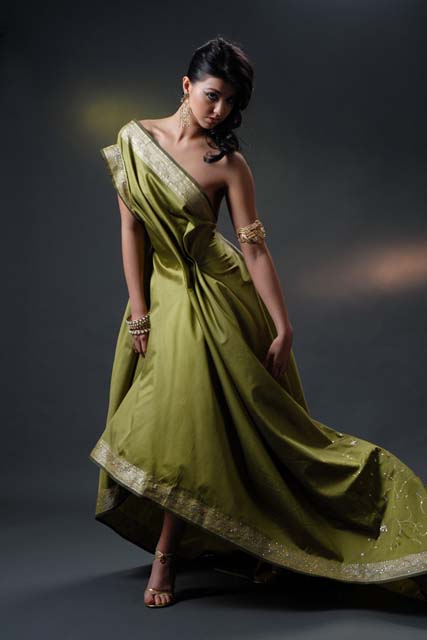
India Fashion Boom
India-inspired fashion has made it to the White House! When President Obama threw his first State Dinner, First Lady Michelle Obama chose to wear a striking champagne colored tulle gown with silver teiki embroidered flowers created by Mumbai-born designer Naeem Khan. Earlier in the day she wore a skirt created by another designer who has her roots in India, Rachel Roy.
Well, India born designers and Indian crafts, fabrics and embroidery seem to have come a long way from the cotton hippie skirts sold in flea markets to the stylish sequin and crystal laden couture of major American designers like Oscar De La Renta, Caroline Herrera, Michael Kors, Vera Wang and Bill Blass, along with European fashion brand names such as Chloe, Valentino, Balmain, Sonia Rykiel, Escada, and Gucci, to name a few.
India is on everyone’s radar with ‘Slumdog Millionaire’ winning Oscars, groups such as the Pussy Cat Dolls doing interpretations of Indian songs, Gwen Stefani and Lindsay Lohan wearing bindis, and Rihanna and Madonna in Hindi printed scarves and mehndi., not to mention the White House gatecrasher resplendent in a bright red sari!
From Bollywood dance to dosas to pashmina shawls, everything Indian seems to have a fan following in America. A lot of it has to do with globalization and India’s enhanced role in the world, but in reality Indian crafts and colors have colonized the imagination of Western designers, artists and writers through the years.
Many are the travelers who’ve journeyed to India and found it to be a bottomless well of inspiration for color, style and crafts. Indian silhouettes of the churidar or tight pants as well as the kurti have been incorporated into the fashion language of major designers, and these can be found in upscale stores from Neiman Marcus to Saks Fifth Avenue.
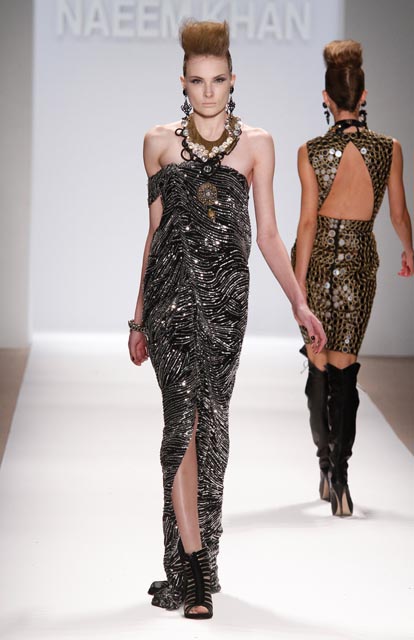
After Naeem khan designed Michelle Obama’s gown, he became the third most Googled name in the world and the media buzz was intense. In designing the First Lady’s gown, Khan hit just the right tone of classic and contemporary. “I took some very abstract flowers inspired by Andy Warhol and I put the old teiki work into that,” he says. “But then I cut the dress into a very modern strapless dress for her because she’s tall and has perfect shoulders. So the fabrication is very old world India but the shape of the dress is very modern.”
This juxtaposition of old and new is what appeals to the Western consumer. His other high profile clients include Queen Noor of Jordan, Beyonce, Kim Catrall, Eva Longoria, Debra Messing, Carrie Underwood, Katherine Heigl and Taylor Swift. Recently Marissa Mayer of Google was married in a Naeem Khan dress, and his clothes are sold in over a hundred stores internationally.
Director Mira Nair describes his appeal thus: “Naeem’s clothes are sumptuous and sexy – he combines the ancient aesthetic of Indian craftsmanship with his own inimitable spin, creating beautiful modern things that are utterly wearable.”
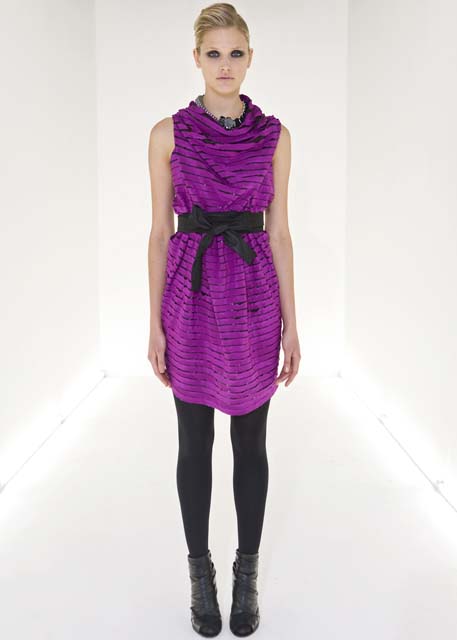
One thing is certain – the whole nine yards of the ornate Indian look which is so popular in Indian bridal fashion cannot be exported wholesale, if it has to succeed in the western market. A small whiff of India goes a long way, and is all that is needed to give a unique touch to contemporary clothing worn in the west. Several designers in India have successful partnerships with stores and boutiques abroad, and their offerings for the western market are quite different from the products for the home market.
Designer Manish Arora is a dramatic success story who has mastered the language of design to get audiences in all countries. He has participated in the Paris, London, Hong Kong and India Fashion weeks, his label is available in over 84 stores worldwide, and he collaborates with Reebok on his hugely successful ‘Fish Fry’ line, which is available in the US.
An exciting new innovation is occurring in fashion with the entry of Indian-Americans into the many different fields of the American fashion market. Having studied and grown up in the US, these designers, stylists and entrepreneurs bring their own unique sensibilities to the arena. Aru Kulkarni is the President of Sales at the Jones Apparel Group, and has Been VP at Liz Claiborne; Roopal Patel is the Fashion Director at Bergdorf Goodman; Aria Das is a fashion stylist with Bloomingdales; and Mili Dutt Reddy is Manager of Sales Forecasting and New Products at Louis Vuitton NA.
Sachin and Babi Ahluwalia are a New York based husband and wife team whose company ANK Embroideries designs and manufactures couture embroideries for some of the biggest American fashion brands. As they point out, “What the general public doesn’t realize is that Indian embroidery, textiles and craftsmanship are already a major influence within the industry across the board.”
The couple also own ANKASA, a luxury home furnishings brand steeped in Indian fabrics and crafts where they combine “what is chic and classic with what is edgy and trend driven.” Just a year back they launched their fashion label “Sachin and Babi” in which they experiment with textures and silhouettes. The price point makes this stylish line accessible to consumers.
As someone who’s been active in the home interiors and fashion industry, what changes has Babi seen in how India is perceived by buyers and the media? “I think India has a more elevated presence and is well accepted because of its diverse facets. It has become more about preserving the arts and handicrafts rather than just factories. We manufacture our line in India, but design and conceptualize it here in New York.”
Asked if designers from India can break into the US market, she says, “Yes, it is possible for an Indian designer to break into the US fashion market – I am a living example of that! However, you do have to modify to the market. If you can understand the quintessential American lifestyle and cater to it, you will do well.” She points out that living in the US and being immersed in the culture gives one an innate sense of what the market needs, appreciates and requires.
In Atlanta, another young designer of Indian origin is bringing the Indian sensibility to her creations – without ever having gone to India! India, it seems can be a state of mind. Christine Philip, a graduate of Emory University, apprenticed with a master European couturier before launching couture collection. As it is happening more and more, Indian born designers are bringing different influences to the mix. Philip has German and Portuguese heritage too, has lived in the Middle East and traveled in Europe and the Far East. Her label is CP Fusao, a tribute to her Portuguese grandma who hailed from the Madeira Wine family.
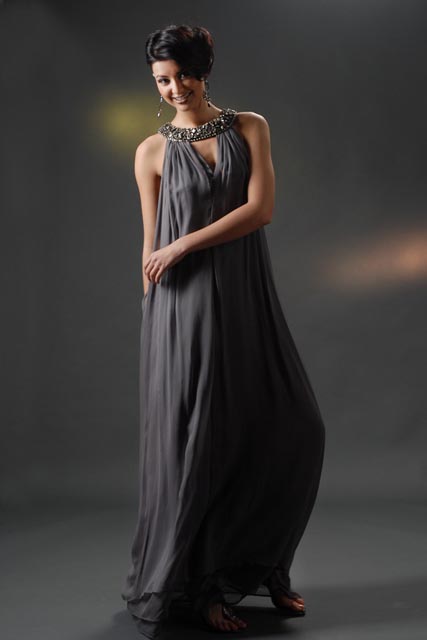
Fashion for these young Indian-American designers is a constant dialogue and she recently hired Anthony Williams from Neiman Marcus as her creative director and a designer for CP Fusao. Williams is currently competing in the hot television series, Project Runway. “India has always been on the minds of buyers and the media and you can’t go into a high-end store without running into something influenced by Indian culture,” she says.
“Even renowned designers are looking more and more towards Indian inspired trends in fashion and are taking it from day to evening wear such as: Michael Kors, the late Alexander Mcqueen, Oscar de La Renta, Marchesa, Armani, and Badgley Mischka to name a few. India is making a global impact in their extravagant silks, vibrant colors, lush embroidery, and its undeniably exotic flavor.”
Philip, who has recently launched a style magazine called ‘Global Glam’ feels that while Indian elements such as embroidery, embellishments and silks are already big in fashion, designers from India are not that well-known in the market yet.
Some young style-conscious Indian-Americans are looking to change that. Misha Shivdasani is launching Misha Nicole in Fall 2010 as a retail concept store and event space. “The mission is to create a fresh, cultural, and engaging shopping experience,” says Shivdasani. “It is being established as the premier platform to showcase coveted designers that have strong brand recognition internationally, but aren’t represented in the U.S.
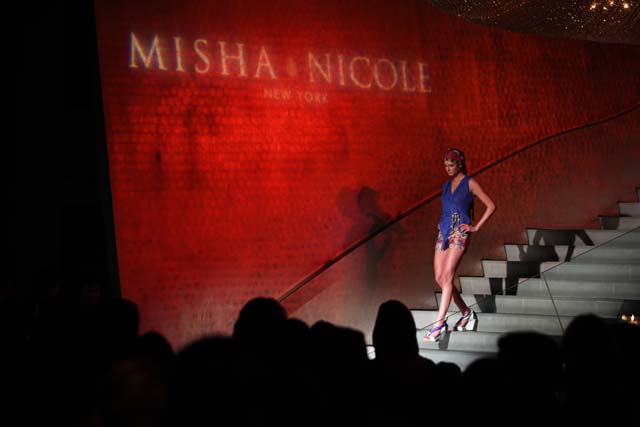
Shivdasani, who has been a buyer for Bergdorf Goodman and worked with Neiman Marcus and Salvatore Ferragamo in sales, really knows her stuff. “With the over saturation of the luxury brands in the market, the exorbitant prices and the demise in quality, consumers don’t feel as inclined to invest into the mainstream brands that are becoming less unique and interesting, and don’t make up for it with the quality,” she says.
“So India provides product that is exciting, has a unique perspective, and is diversified in its range of product offering. The media and buyers are realizing that this is where the goldmine is, and consumers want to purchase items that are fresh and exciting, but do not want to break the bank. India not only provides newness, but also prices that are competitive.”
In the tough economic atmosphere, when stores are being shuttered, is it smart to bet on India and open a store dedicated to Indian style and fashion? “It couldn’t be a better time,” says Misha Shivdasani as she launched this April with Global Runway, a fashion event at the Paramount Hotel to inaugurate Misha Nicole. “People are excited about India and fashion that provides uniqueness, quality and a good price, and that is what India can provide. India is on the upswing, and investing now is the time.”
A designer who would attest to that is G. Pia Fleming, whose line BIAN by G. Pia Fleming has really taken off internationally. Calling her on her cell phone in New York, I got her instead in the middle of the night in New Delhi! She was jetlagged, having flown from New York to Dubai to New Delhi, in time for Fashion Week. In the last few years BIAN has become a brand name in the Middle East, Australia and Japan, and scores of boutiques in the US carry the line. Fleming has now a flagship store in Delhi, and is involved with the Fashion Week carnival in India.
She has certainly paid her dues and shows how fashion careers are going full circle globally. She was among the first batch of students to graduate from NIFT in Delhi, which was created in collaboration with the Fashion Institute of Technology in New York, and under the guidance of the dean of FIT, she came to study in the US, and interned with Tommy Hilfiger and at Nordstrom.
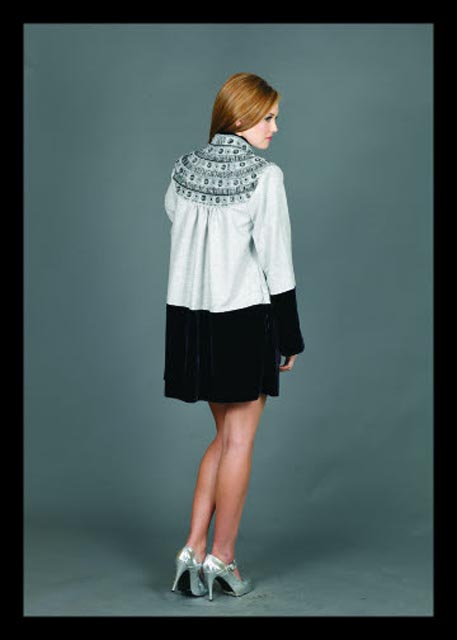
Fleming launched BIAN in New York in 2002, and then participated in Toronto Fashion Week. Tellingly enough, BIAN means mysterious – in Vietnamese! So Indian workmanship doesn’t always have to have a geographical identity and is merging itself into many styles and sensibilities. China and other countries may be useful for mass fabrication but India remains the place of choice for intricate craftsmanship and techniques such as zardozi, appliqué, beading and crocheting. The experience of hundreds of years is now being tapped by designers both in India and abroad.
Yes, the times might be tough, but young entrepreneurs are betting on India in the luxury and style market. This fall, exclusive Madison Avenue, is going to get an Indian store along with its noted neighbors such as Chanel, Armani, Dolce and Gabbana, Hermes and Roberto Cavalli, which are all on this street of high fashion. Soigne K is a multi-brand specialty store being launched by Soigne Kothari, an entrepreneur who graduated from FIT in buying and merchandising.
“India’s greatest and latest designers have found their way onto prestigious runways and upscale retailers of the world,” she says. “My vision is to bring the best and brightest Indian designers to the US, while primarily being a fashion destination for women of America seeking a unique and modern style.”
She adds: “Soigne K represents the perfect mix of approachable Indian pieces which appeal to the Western market, and traditional Indian formal wear. The store will also celebrate India by serving as an educational portal to learn more about the craftsmanship, quality and intricacies of the clothes.”
And so as spring turns into fall, we should be seeing a lot of excitement and action in the fashion arena. Will more and more Americans be seduced by Indian fashion through travel to India, through cinema, and through Indian-American friends in an ever increasing Asian population? Will American designers continue to find inspiration in India’s myriad delights of color, crafts and couture? Will Indian designers make it big in America? Will new mega-fashion stores dedicated to India ring up the sweet music of cash registers?
As global influences permeate countries and as people move effortlessly across borders, brought closer by the Internet and virtual worlds, this seems very likely. Stay tuned as the fashion story continues!
© Lavina Melwani
This article first appeared in Khabar magazine
Related Articles
Naeem Khan Designs for Michelle Obama
Misha Nicole Brings India to America
Sabah Mansoor at New York’s Fashion Week

4 Comments
Lovely article
Hi Bonnie,
You can certainly buy that dress, please email me at cpfusao.ny@gmail.com.
-Christine
Do you know if I can buy that green dress? I love it!
Pingback: Tweets that mention Lassi With Lavina » The Buzz » India on My Mind -- Topsy.com